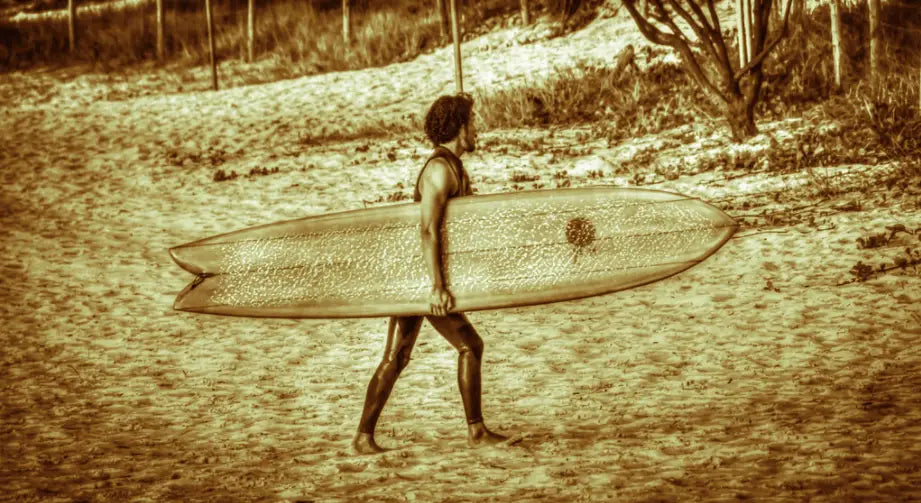Surfboard Tail Designs – What’s the difference between them?
Share
Surfboard tail design has evolved over the years, and, as with most things, necessity has been the mother of invention...
The original square tail was crude and utilitarian. It provided lift, a good planing surface, and a semblance of maneuverability, but very little stability. The pintail, on the other hand, was designed to give gunny single-fin boards control. The pin tapers to a point, which lengthens the outline of the board without adding too much volume, allowing it to anchor in the face of even the biggest and hollowest of waves. Today, pintails are still used on big wave guns to provide ultimate control at high speed in powerful waves, whereas a true square tail is largely a thing of the past.
Round Tails
Round tails (and all of their various nuanced manifestations, including rounded pins and thumbnails) are essentially a softer, less extreme evolution of the pin tail to provide smoother maneuverability and more lift in the tail, but without completely sacrificing the stability and control of a pin. These rounded tails fit into the concave face of a hollow wave, and lend themselves to high-performance surfing in barreling waves, providing control in the tube and a smooth, powerful arcing turn at high speed. They are commonly used on mini-guns, stepups, and other shortboards intended for punchy, hollow waves.
Original Deep Swallow Tails

The original deep swallow tail was developed as a response to twin-fin boards. While we often think of the swallow tail as a good design for a loose, rippable thruster, it was originally intended to serve as a pair of pintails—one for each of the two keels on a twin-fin fish. These early swallow tails were very deep, so the two tips of the tail actually looked somewhat like two pins—and again, this pair of pin tails served as two points of control behind the fins. Due to the width of the “tail” created by the outside edges of the two tips, these boards had straighter rails, more tail volume and a greater surface from which to turn, which made them more skatey and responsive. However, the v-shaped cutout that essentially created two pins also provided some control and bite. These deep swallow tails are still commonly seen on retro fish.
Squash Tails
The squash tail essentially takes the volume of a round tail and adds corners, providing even more volume and rounded angles from which to pivot, while the flat rear surface of the board allows for more slide and release out of a carve or snap. This high-volume, highly maneuverable tail is typically combined with a thruster setup, which makes up for the diminished control that is inherent in a squash tail. While a greater variety in board shape and tail design is being seen in shops these days, for many years, the squash-tail thruster was the high-performance design of choice.
Modern Swallow Tails
The modern swallow tail is essentially a squash tail with a shallow v-shaped cutout between the two corners. Like the deeper original swallow tail, this allows a board to maintain a straighter rail back to the tail, increasing volume, lift, and planing speed while also adding a little more release and pivot due to the missing foam between the slightly more pronounced tips. While modern swallow tails are often associated with small-wave grovelers (since they work well with quads, and provide added lift without completely sacrificing pivot and bite), they are also sometimes used on boards intended for power carving in beefy waves. They even show up on guns and barrel boards from time to time, although these big-wave swallows are typically combinations of a narrow, drawn-in pin tail rail with a little extra width right at the end of the board (provided by the twin-tips of the swallow tail, rather than the traditional single pin).
If this seems like a lot of information to digest, you can always boil it down to a few basic concepts...
Generally speaking, all tail designs are combinations between square tails and pintails. The wider a tail is, the more lift and planing speed it will have, but at the sacrifice of control. For this reason, wider, more voluminous tails are typically used on small-wave boards and grovelers.
Narrow, pointed tails will provide less speed and maneuverability, but more control at high speeds and in hollow wave faces, which is why pin tails are typically used in guns and rounded pins in mini-guns and stepups.
A softer, rounder rail will lend itself to holding a carve in a hollow face, while corners and tips will provide a pivot point from which to release into sliding maneuvers.
Every tail on virtually every board ever shaped is essentially a combination of these four elements, including bat tails, diamond tails, and just about anything else you can dream up. By taking into account the style of surfing you do and what waves your next board is being built for, you can work with your shaper to hone in on exactly what your tail should look like. Photo Credit: Petra Bensted
You Might Also Like:
👉Quick Board Repair on the Run Swells 101: How are Waves Formed? Swells 102: Ground Swell Versus Wind Swell
👉Who and What is Thunderbolt Technologies?
👉World Champion Taylor Jensen and His Wife Nava Young—the First Family of Modern Longboarding

